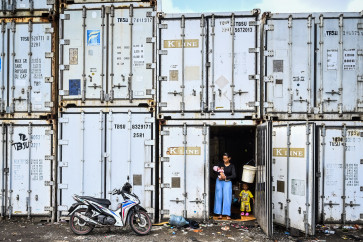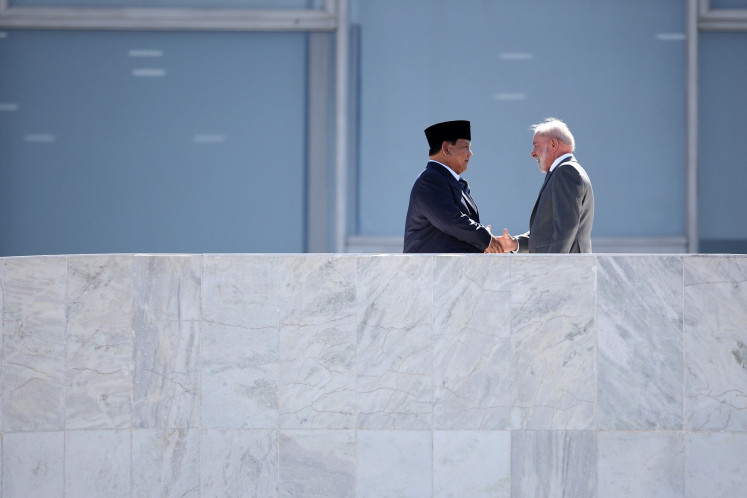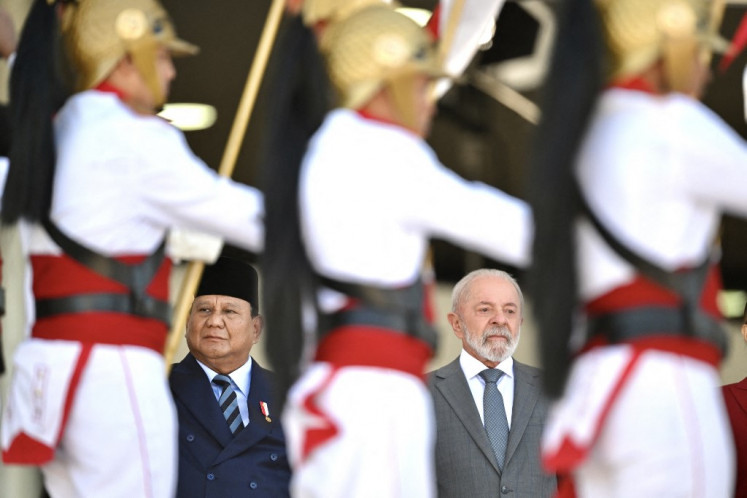Popular Reads
Top Results
Can't find what you're looking for?
View all search resultsPopular Reads
Top Results
Can't find what you're looking for?
View all search resultsExploring the world of dragons
Way of the Dragon: Guh paints with his body, using mud and dried leaves as paint
Change text size
Gift Premium Articles
to Anyone
Way of the Dragon: Guh paints with his body, using mud and dried leaves as paint.
The dancer moved gracefully and vigorously, stepping along a muddy path in a mangrove forest in Badung, Bali, in October.
The fair-skinned man was followed by another man and five women clad in white, all shifting dynamically to the accompaniment of a flute made from mangrove wood.
Guh S. Mana, the lead artist from Solo, Central Java, approached a canvas and danced in front of it.
Balinese-tinged music and the smoke from the incense carried by the women created a mystical atmosphere for the performance.
The painter kept dancing to the music of the flute, moving irregularly as he drew patterns on the canvas.
Instead of using a paintbrush and watercolors, the artist used his body and a bowl of ink made from the dried leaves of mangrove trees and mud to paint.
Enter the dragon: Artist Guh in the middle of a performance piece.
After outlining uneven strokes, Guh wound up his 'action-painting' by ripping off the clothes of the man following him and removing a mangrove-wood carving from the man's chest to be attached to his canvas.
A painting of a dragon began to take shape.
The performance and was titled Become the Dragon, told the story of Jaya Pangus, a legendary king of Bali. Guh discussed the show in Solo in November. 'I was trying to depict the moment when Jaya Pangus turned into a dragon.'
After Jaya Pangus left his wife, a Chinese princess, to meditate in a forest; he married another woman, Dewi Danu, who gave him a son.
Eventually, the Chinese princess found Jaya Pangus and his child in the forest, revealing the king's infidelity. As punishment, Jaya Pangus was cursed to become a dragon to safeguard the people of Bali.
'The dragon is now manifested in a giant puppet called Barong Landung, or Ratu Gede Mecaling,' Guh said.
Guh, who is of Chinese and Javanese ancestry, says he has been obsessed with naga, or dragons. 'The dragon is the most famous mythical creature, found in nearly every part of the world.'
In Chinese mythology, the dragon represents power, vitality, glory ' and unity, Guh adds. 'The dragon is also one of the 12 Chinese astrological signs, or shio, and its internal organs turn out to be a combination of body parts of the other animals in the Chinese shio, which makes it very special to me.'
Before Become the Dragon, Guh staged Naga in Harmonious Spirit and Mind in Karanganyar, Central Java in 2012, displaying ten dragon-themed paintings for the occasion.
In the same year, Guh also presented his dragon paintings at a show titled Dreams of Naga, in Solo and Yogyakarta. 'I've also been searching for Javanese versions of the dragon by visiting the Cirebon Sultanate Palace to observe dragon carvings there.'
His most recent show stemmed from research into dragons in Balinese mythology. 'Finally I found the Jaya Pangus legend,' he said.
Guh is known as Solo's unique action-painting artist. His painting is always theatrically performed with musical accompaniment.
He is also engaged in experimental painting, using uncommon materials and means of creation. Guh once painted with his all his body parts ' including his hair, lips, hands and feet.
Food and mud are also used as non-traditional paints by the artist.
In 2009, Guh won an award from the Indonesian Records Museum (MURI) in the unique art category for painting underwater.
Born on February 11, 1968; Guh is preparing an exhibition of dragon paintings and photos with the theme of 'Naga RI', or Dragons of the Republic of Indonesia, for the show.
For Guh, the dragon's integration of various animals in the Chinese zodiac is a metaphor for the national motto of bhinneka tunggal ika, or unity in diversity. 'I wish to illustrate Indonesia as a dragon,' he says.











